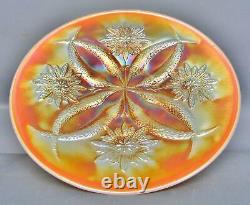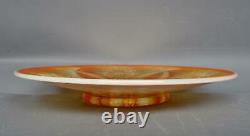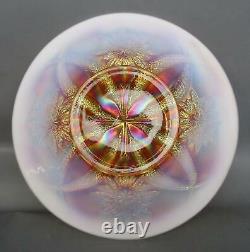C082 Dugan FOUR FLOWERS Peach Opalescent Carnival Glass 6½ Smooth Edge Plate





Gorgeous 6½ Peach Opalescent Carnival Glass FOUR FLOWERS Plate with Smooth Edge and Plain Exterior by Dugan, in excellent undamaged antique condition. Was Harry Northwood's cousin.
The Dugan Glass Company was born when, in 1904, Dugan and his associates bought Harry Northwood's old Indiana, Pennsylvania plant, from which Northwood had moved in 1901. The company changed hands in 1913 to become the Diamond Glass Company and remained thus until the factory burned to the ground in 1931. Diamond Glass continued many Dugan patterns, so attribution is often listed as Dugan/Diamond. Is what we now call IRIDIZED patterned pressed glass introduced by the Fenton Art Glass Company in 1907, and produced by numerous glass makers through the 1930s.
Bowls, plates, water sets (pitcher with tumblers), dresser sets (powder box, tray, pin tray, hat pin holder, cologne/perfume), table sets (sugar, creamer, butter, spooner), vases and specialty pieces were given a vivid and colorful appearance by a microscopically thin coating of metal applied as a solution of one or more metallic salts stannous chloride [tin], iron chloride, lead chloride, et. By hand-spraying the hot-from-the-mold glass. The carrying solution vaporized leaving the metallic salts to bond on a molecular level with the glass, producing a surface that reflected light in a rainbow of colors.Each salt or combination of salts produced a different color, with intensity tied to the thickness of the coating. Item has no post-production damage such as chips or cracks.
It may have discernible minor wear from usage and/or nesting (stacking). In the early 1900s were dirty and dangerous and there was no "Quality Control" as we now know it, any number of the following production issues. Air bubbles in the glass that were not squeezed out during pressing. Heat checks which are internal rifts filled with air (which is why you can see them), usually from a burst air bubble. Inclusions in or on the surface of the glass, such as ash and cinders.
Often found in the flames of vases and rims of bowls were it settled during pressing. Strands of undissolved colorant (usually in green glass). In the glass caused by premature solidification where the molten glass was. Snipped from the gathering rod with cool metal shears when the mould was full; lines also formed on the surface during the cooling process.
Tool marks from implements used to form the edge or influence the shape. Mold issues related to filling and release such as incomplete or malformed edges.
Rough seams, extra glass at seams; webbed, incomplete or pulled edge points. Uneven legs, slanted stems or a bowed base (causing rocking), surface lines and heat checks. Production issues in the extreme may be undesirable, but they do not qualify as "damage" and will be found to some degree on nearly all antique glassware.
Issues of MAJOR wear and production flaws will be mentioned and photographed; please check photos carefully as they are a part of the description. All items are bubble wrapped. No tape is used on the bubble wrap YAY! Carton voids are filled with cushioning peanuts. Cartons are labeled GLASS or FRAGILE, and. Get images that make Supersized seem small. Showcase your items with Auctiva's.The item "C082 Dugan FOUR FLOWERS Peach Opalescent Carnival Glass 6½ Smooth Edge Plate" is in sale since Saturday, May 8, 2021. This item is in the category "Pottery & Glass\Glass\Glassware\Carnival Glass\Vintage (Pre-1940)\Dugan". The seller is "carnivalglasskingdotnet" and is located in Rock Spring, Georgia. This item can be shipped worldwide.
- Pattern: Four Flowers
- Glassmaking Technique: Pressed and Iridized
- Original/Reproduction: Antique Original
- Production Style: Carnival
- Object Type: Plate
- Color: Peach Opalescent
- Brand: Dugan
- Time Period Manufactured: Vintage (Pre-1940)

